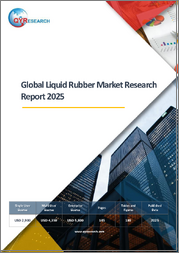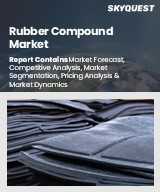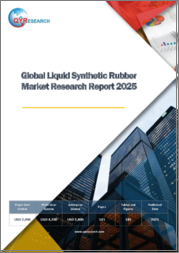
|
시장보고서
상품코드
1457106
세계의 합성 고무 장갑 시장 예측(2024-2029년)Synthetic Rubber Gloves Market - Forecasts from 2024 to 2029 |
||||||
합성 고무 장갑 시장은 2022년 95억 9,700만 달러로 평가되었습니다.
합성 고무 장갑은 라텍스가 없는 장갑이지만 라텍스 장갑과 비슷한 특성을 가지고 있습니다. 장갑은 화학 물질 및 많은 산업에서 일하는 노동자의 피부에 영향을 미칠 수 있는 물질과 같은 다양한 위험으로부터 보호하기 위해 산업의 중요한 부분으로 보입니다.
합성 고무 장갑 수요를 촉진하는 주요 요인으로는 고용자의 노동자의 안전에 대한 관심의 고조나, 청소나 세탁 등 다양한 용도로 가정용 장갑의 채용이 확대되고 있는 것 등을 들 수 있습니다. 게다가 라텍스 알레르기 환자 수 증가로 장갑 채용 확대도 향후 5년간 시장 성장에 긍정적인 영향을 미치는 주요 요인 중 하나입니다.
또한 Australasian Society of Clinical Immunology and Allergy(ASCIA)에 따르면 라텍스 알레르기는 최근 몇 년동안 특히 의료 환경에서 일하는 사람들에게 중요한 건강 문제가 되었습니다. 합성 장갑은 네오프렌과 니트릴과 같은 라텍스가없는 재료로 만들어져 있으며 가격도 상당히 안정적이며 알레르기가 없습니다. 따라서 다양한 산업 기업들이 고무 장갑에서 합성 장갑으로 전환하고 있습니다.
시장 성장 촉진요인:
- 라텍스 알레르기의 이환율 증가가 시장 성장의 원동력이 될 것으로 예상됩니다.
의료 종사자들 사이에서 라텍스 알레르기의 발생률이 상승하고 있는 것이 합성 고무 장갑 시장의 주요 촉진요인이 되고 있습니다. 세계 사람들이 의료용 및 산업용 장갑 제조에 사용되는 천연 고무 라텍스에 포함된 특정 단백질에 알레르기 반응을 일으키는 경우가 늘고 있습니다. 성장하는 의료 부문은 향후 몇 년동안 가장 큰 고용 창출원이 될 것으로 예상됩니다. 세계 인구가 증가함에 따라 의료 서비스에 대한 수요는 전 세계적으로 급증하고 있습니다.
유엔 사회경제국에 따르면 세계 인구는 2015년 73억 명에서 2030년 85억 명으로 증가할 것으로 예측됩니다. 게다가 미국, 일본, 중국 등의 국가에서 노인 인구가 증가하고 있는 것도 재택치료 솔루션과 서비스 수요를 촉진하고 있습니다. 따라서 의료 종사자는 라텍스 노출의 가장 높은 위험에 노출됩니다. 미국 라텍스 알레르기 협회에 따르면 미국의 의료 종사자의 8-17%가 천연 고무 라텍스에 감작되고 있습니다. 따라서 이러한 모든 요인은 특히 신흥 경제 국가에서 합성 고무 장갑 수요를 밀어 올리고 있습니다. 또한, 알레르기의 원인이 되는 라텍스 단백질을 측정하는 표준화된 방법이나 라텍스 알레르기의 피부 테스트용으로 FDA가 승인한 재료가 없는 것도 합성 장갑 수요를 더욱 뒷받침하고 있습니다. 이 장갑은 비 알레르기 성뿐만 아니라 라텍스 장갑과 달리 훨씬 강하고 내 천자성이 있습니다.
- 의료 부문 수요가 시장 성장을 이끌 것으로 예상됩니다.
합성 고무 장갑 장갑은 의료 현장에서 감염 확대를 방지하고 의료 종사자와 환자 사이에 장벽을 제공하는 데 필수적입니다. 장갑은 시험, 수술, 환자 관리와 같은 의료 절차에서 일상적으로 사용됩니다. 감염의 유행과 유행의 경우, 의료 시스템이 감염 대책에 주력하기 때문에 장갑 수요가 증가합니다. 재택치료 서비스 확대도 장갑 수요에 기여하고 있습니다. 의료 관행, 규제 변경, 세계 건강 이벤트를 모니터링함으로써 합성 고무 장갑 시장의 진화하는 역학에 대한 통찰력을 얻을 수 있습니다.
의료 부문에서는 감염 예방 및 관리 대책으로서 특히 라텍스가 없는 합성 고무 장갑이 유용합니다. 의료 현장에서 엄격한 안전 기준의 필요성으로 고품질의 일회용 장갑 수요가 급증하고 있습니다. 의료 전문가는 이러한 지침을 준수해야하며 장갑은 그들의 보호 장비의 중요한 부분이되었습니다. 위생에 대한 의식의 고조와 감염 예방·관리 대책의 필요성이, 의료 부문에 있어서의 합성 고무 장갑의 안정된 수요에 기여하고 있습니다.
합성 고무 장갑 시장은 재료, 최종 사용자 산업, 지역에 따라 구분됩니다. 재료별로는 니트릴, 네오프렌, PVC, 부틸 등으로 분류됩니다. 최종 사용자 산업별로 시장은 의료, 식품, 화학, 전자, 자동차 등으로 구분됩니다. 합성 고무 장갑 시장은 북미, 남미, 유럽, 중동, 아프리카, 아시아태평양으로 지리적으로 분류됩니다.
지역별
북미의 의료 인프라는 엄격한 안전 기준, 유행에 대비, 기술 진보, 라텍스 알레르기 인식, 노동 안전 관행, 의료 지출 증가로 합성 고무 장갑에 대한 의존도가 높습니다. 이 지역에서는 라텍스가없는 대체품이 선호되고 의료 시설의 확대와 현대화는 합성 고무 장갑을 포함한 의료 용품의 지속적인 수요에 기여합니다. 북미, 특히 미국은 선진적인 의료 인프라, 의료 시설, 연구 기관, 전문가를 옹호하고 암 치료에 주도적인 역할을 담당하고 있습니다. 이 지역은 의료 연구 및 기술 혁신의 중심지이며, 제약 회사 및 생명 공학 기업과 같은 주요 기업이 시장 점유율에 기여하고 있습니다. 미국 식품의약국은 암 치료의 승인과 상업화에 중요한 역할을 하고 있습니다. 또한 전자상거래 플랫폼의 성장은 의료 및 안전 제품의 용이한 조달을 촉진하고 합성 고무 장갑의 접근성과 유통에 기여하고 있습니다. 의료 및 안전 기준에 관한 정부의 이니셔티브와 규정은 합성 고무 장갑 수요에 영향을 줄 수 있습니다. 공중 보건 의식, 특히 위생 및 감염 예방 의식은 공공성이 높은 다양한 산업에서 합성 고무 장갑에 대한 수요를 촉진하고 있습니다.
목차
제1장 서론
- 시장 개요
- 시장의 정의
- 조사 범위
- 시장 세분화
- 통화
- 전제조건
- 기준년과 예측년의 타임라인
- 이해 관계자에게 있어서의 주요 이점
제2장 조사 방법
- 조사 디자인
- 조사 과정
제3장 주요 요약
- 주요 조사 결과
- 애널리스트 보기
제4장 시장 역학
- 시장 성장 촉진요인
- 시장 성장 억제요인
- Porter's Five Forces 분석
- 업계 밸류체인 분석
- 애널리스트 보기
제5장 합성 고무 장갑 시장 : 재료별
- 소개
- 니트릴
- 네오프렌
- PVC
- 부틸
- 기타
제6장 합성 고무 장갑 시장 : 최종 사용자 업계별
- 소개
- 의료
- 음식
- 화학약품
- 일렉트로닉스
- 자동차
- 기타
제7장 합성 고무 장갑 시장 :지역별
- 소개
- 북미
- 남미
- 유럽
- 중동 및 아프리카
- 아시아태평양
제8장 경쟁 환경과 분석
- 주요 기업과 전략 분석
- 시장 점유율 분석
- 합병, 인수, 합의와 콜라보레이션
- 경쟁 대시보드
제9장 기업 프로파일
- Candela Corporation
- Allergan
- Merz Pharma
- Mentor Worldwide LLC
- Lumenis
- Sinclair Pharma
- Cutera
The synthetic rubber gloves market was valued at US$9.597 billion in 2022.
Synthetic rubber gloves are latex-free gloves but offer similar properties to latex gloves. Gloves are considered an important part of the industry as they offer protection from a wide variety of hazards such as chemicals, and substances that may affect the skins of the workers working across the numerous industry verticals.
The major factors driving the demand for synthetic rubber gloves include employers' rising focus on workers' safety and the growing adoption of these gloves across the household sector for various applications such as cleaning and washing, among others. In addition, the growing adoption of these gloves due to the rising number of cases of latex allergy is also one of the prime factors positively impacting market growth during the next five years.
Also, according to the Australasian Society of Clinical Immunology and Allergy (ASCIA), latex allergy has become an important health concern for workers, especially in healthcare environments in recent years. Synthetic gloves are made of latex-free materials like neoprene, and nitrile that are also fairly stable in pricing and are non-allergic. This, in turn, is encouraging companies across the various industry verticals to shift from rubber gloves to synthetic gloves.
MARKET DRIVERS:
- The growing incidence of latex allergy is expected to drive the market growth.
The rising incidence of latex allergy among healthcare workers is the major driver of the synthetic rubber glove market. People across the globe are increasingly developing allergic reactions to certain proteins present in natural rubber latex that are used to make both medical and industrial gloves. The growing healthcare sector is projected to be the largest source of job creation in the coming years. The increasing global population is leading to a mushrooming demand for healthcare services worldwide.
According to the United Nations Department of Social and Economic Affairs, the world population is projected to grow from 7.3 billion in 2015 to 8.5 billion in 2030. Furthermore, the growing geriatric population in countries like the U.S., Japan, and China is also driving the demand for home healthcare solutions and services. Healthcare workers are, thus, at the highest risk of latex exposure. According to the American Latex Allergy Association, 8-17% of healthcare workers in the U.S. are sensitized to natural rubber latex. Thus, all these factors are boosting the demand for synthetic rubber gloves, especially in developed economies. Moreover, a lack of standardized methods to measure allergy-causing latex proteins and FDA-approved materials for skin testing for latex allergy further supports the demand for synthetic gloves. These gloves are not only non-allergenic but much stronger and provide puncture resistance, unlike latex gloves.
- Demand in the healthcare sector is anticipated to drive the growth of the market.
Synthetic rubber gloves are essential in healthcare settings for preventing infection spread and providing a barrier between healthcare professionals and patients. They are routinely used in medical procedures, including examinations, surgeries, and patient care. The demand for gloves increases during outbreaks and pandemics, as healthcare systems focus on infection control. The expansion of home healthcare services also contributes to the demand for gloves. Monitoring healthcare practices, regulatory changes, and global health events will provide insights into the evolving dynamics of the synthetic rubber gloves market.
The healthcare sector heavily relies on synthetic rubber gloves, particularly latex-free ones, for infection prevention and control measures. The demand for high-quality disposable gloves has surged due to the need for strict safety standards in healthcare settings. Healthcare professionals are required to adhere to these guidelines, making gloves a crucial part of their protective gear. The increasing awareness of hygiene and the need for infection prevention and control measures contribute to the consistent demand for synthetic rubber gloves in the healthcare sector.
The synthetic rubber gloves market has been segmented based on material, end-user industry, and geography. Based on material, the market has been classified into nitrile, neoprene, PVC, Butyl, and others. By the end-user industry, the market has been segmented into healthcare, food and beverage, chemicals, electronics, automotive, and others. The synthetic rubber gloves market has been classified geographically into North America, South America, Europe, the Middle East and Africa, and Asia Pacific.
By Geography
North America's healthcare infrastructure is highly reliant on synthetic rubber gloves due to strict safety standards, pandemic preparedness, technological advancements, latex allergy awareness, occupational safety practices, and increased healthcare spending. The region's preference for latex-free alternatives and the expansion and modernization of healthcare facilities contribute to sustained demand for medical supplies, including synthetic rubber gloves. North America, particularly the United States, is a leading player in cancer treatment due to its advanced healthcare infrastructure, medical facilities, research institutions, and professionals. The region is a hub for medical research and innovation, with key players like pharmaceutical companies and biotechnology firms contributing to market share. The U.S. Food and Drug Administration plays a crucial role in the approval and commercialization of cancer treatments. The growth of e-commerce platforms also facilitates easy procurement of healthcare and safety products, contributing to the accessibility and distribution of synthetic rubber gloves. Government initiatives and regulations related to healthcare and safety standards can influence the demand for synthetic rubber gloves. Public health awareness, particularly in hygiene and infection prevention, also drives the demand for synthetic rubber gloves in various public-facing industries.
Key Developments
- March 2022- Malaysian glove manufacturer Supermax Corporation Berhad has unveiled its Advance Manufacturing Facility in Brazoria County, Texas, marking its 18th manufacturing plant globally and first in the US. The 215-acre facility will use artificial intelligence and robotic engineering, and will consist of eight buildings.
- January 2021- Ansell Limited, a specialist in protection solutions, has acquired the Primus brand and associated properties, including Primus Gloves and Sanrea Healthcare Products Life Science company. Primus is an Indian manufacturer and marketer of gloves in the Life Science and Specialty Medical sectors, and is one of the few global producers of long-cuff gloves with strong brand recognition. Ansell and Primus have entered into a long-term supply partnership.
Market Segmentation
By Material
- Nitrile
- Neoprene
- PVC
- Butyl
- Others
By End-User Industry
- Healthcare
- Food and Beverage
- Chemical
- Electronics
- Automotive
- Others
By Geography
- North America
- United States
- Canada
- Mexico
- South America
- Brazil
- Argentina
- Others
- Europe
- Germany
- France
- United Kingdom
- Spain
- Others
- Middle East and Africa
- Saudi Arabia
- Israel
- Others
- Asia Pacific
- China
- Japan
- South Korea
- India
- Taiwan
- Thailand
- Indonesia
- Others
TABLE OF CONTENTS
1. INTRODUCTION
- 1.1. Market Overview
- 1.2. Market Definition
- 1.3. Scope of the Study
- 1.4. Market Segmentation
- 1.5. Currency
- 1.6. Assumptions
- 1.7. Base, and Forecast Years Timeline
- 1.8. Key Benefits to the stakeholder
2. RESEARCH METHODOLOGY
- 2.1. Research Design
- 2.2. Research Processes
3. EXECUTIVE SUMMARY
- 3.1. Key Findings
- 3.2. Analyst View
4. MARKET DYNAMICS
- 4.1. Market Drivers
- 4.2. Market Restraints
- 4.3. Porter's Five Forces Analysis
- 4.3.1. Bargaining Power of Suppliers
- 4.3.2. Bargaining Power of Buyers
- 4.3.3. Threat of New Entrants
- 4.3.4. Threat of Substitutes
- 4.3.5. Competitive Rivalry in the Industry
- 4.4. Industry Value Chain Analysis
- 4.5. Analyst View
5. SYNTHETIC RUBBER GLOVES MARKET, BY MATERIAL
- 5.1. Introduction
- 5.2. Nitrile
- 5.2.1. Market Opportunities and Trends
- 5.2.2. Growth Prospects
- 5.2.3. Geographic Lucrativeness
- 5.3. Neoprene
- 5.3.1. Market Opportunities and Trends
- 5.3.2. Growth Prospects
- 5.3.3. Geographic Lucrativeness
- 5.4. PVC
- 5.4.1. Market Opportunities and Trends
- 5.4.2. Growth Prospects
- 5.4.3. Geographic Lucrativeness
- 5.5. Butyl
- 5.5.1. Market Opportunities and Trends
- 5.5.2. Growth Prospects
- 5.5.3. Geographic Lucrativeness
- 5.6. Others
- 5.6.1. Market Opportunities and Trends
- 5.6.2. Growth Prospects
- 5.6.3. Geographic Lucrativeness
6. SYNTHETIC RUBBER GLOVES MARKET, BY END-USER INDUSTRY
- 6.1. Introduction
- 6.2. Healthcare
- 6.2.1. Market Opportunities and Trends
- 6.2.2. Growth Prospects
- 6.2.3. Geographic Lucrativeness
- 6.3. Food and Beverage
- 6.3.1. Market Opportunities and Trends
- 6.3.2. Growth Prospects
- 6.3.3. Geographic Lucrativeness
- 6.4. Chemical
- 6.4.1. Market Opportunities and Trends
- 6.4.2. Growth Prospects
- 6.4.3. Geographic Lucrativeness
- 6.5. Electronics
- 6.5.1. Market Opportunities and Trends
- 6.5.2. Growth Prospects
- 6.5.3. Geographic Lucrativeness
- 6.6. Automotive
- 6.6.1. Market Opportunities and Trends
- 6.6.2. Growth Prospects
- 6.6.3. Geographic Lucrativeness
- 6.7. Others
- 6.7.1. Market Opportunities and Trends
- 6.7.2. Growth Prospects
- 6.7.3. Geographic Lucrativeness
7. SYNTHETIC RUBBER GLOVES MARKET, BY GEOGRAPHY
- 7.1. Introduction
- 7.2. North America
- 7.2.1. By Material
- 7.2.2. By End-User Industry
- 7.2.3. By Country
- 7.2.3.1. United States
- 7.2.3.1.1. Market Opportunities and Trends
- 7.2.3.1.2. Growth Prospects
- 7.2.3.2. Canada
- 7.2.3.2.1. Market Opportunities and Trends
- 7.2.3.2.2. Growth Prospects
- 7.2.3.3. Mexico
- 7.2.3.3.1. Market Opportunities and Trends
- 7.2.3.3.2. Growth Prospects
- 7.2.3.1. United States
- 7.3. South America
- 7.3.1. By Material
- 7.3.2. By End-User Industry
- 7.3.3. By Country
- 7.3.3.1. Brazil
- 7.3.3.1.1. Market Opportunities and Trends
- 7.3.3.1.2. Growth Prospects
- 7.3.3.2. Argentina
- 7.3.3.2.1. Market Opportunities and Trends
- 7.3.3.2.2. Growth Prospects
- 7.3.3.3. Others
- 7.3.3.3.1. Market Opportunities and Trends
- 7.3.3.3.2. Growth Prospects
- 7.3.3.1. Brazil
- 7.4. Europe
- 7.4.1. By Material
- 7.4.2. By End-User Industry
- 7.4.3. By Country
- 7.4.3.1. Germany
- 7.4.3.1.1. Market Opportunities and Trends
- 7.4.3.1.2. Growth Prospects
- 7.4.3.2. France
- 7.4.3.2.1. Market Opportunities and Trends
- 7.4.3.2.2. Growth Prospects
- 7.4.3.3. United Kingdom
- 7.4.3.3.1. Market Opportunities and Trends
- 7.4.3.3.2. Growth Prospects
- 7.4.3.4. Spain
- 7.4.3.4.1. Market Opportunities and Trends
- 7.4.3.4.2. Growth Prospects
- 7.4.3.5. Others
- 7.4.3.5.1. Market Opportunities and Trends
- 7.4.3.5.2. Growth Prospects
- 7.4.3.1. Germany
- 7.5. Middle East and Africa
- 7.5.1. By Material
- 7.5.2. By End-User Industry
- 7.5.3. By Country
- 7.5.3.1. Saudi Arabia
- 7.5.3.1.1. Market Opportunities and Trends
- 7.5.3.1.2. Growth Prospects
- 7.5.3.2. Israel
- 7.5.3.2.1. Market Opportunities and Trends
- 7.5.3.2.2. Growth Prospects
- 7.5.3.3. Others
- 7.5.3.3.1. Market Opportunities and Trends
- 7.5.3.3.2. Growth Prospects
- 7.5.3.1. Saudi Arabia
- 7.6. Asia Pacific
- 7.6.1. By Material
- 7.6.2. By End-User Industry
- 7.6.3. By Country
- 7.6.3.1. China
- 7.6.3.1.1. Market Opportunities and Trends
- 7.6.3.1.2. Growth Prospects
- 7.6.3.2. Japan
- 7.6.3.2.1. Market Opportunities and Trends
- 7.6.3.2.2. Growth Prospects
- 7.6.3.3. South Korea
- 7.6.3.3.1. Market Opportunities and Trends
- 7.6.3.3.2. Growth Prospects
- 7.6.3.4. India
- 7.6.3.4.1. Market Opportunities and Trends
- 7.6.3.4.2. Growth Prospects
- 7.6.3.5. Taiwan
- 7.6.3.5.1. Market Opportunities and Trends
- 7.6.3.5.2. Growth Prospects
- 7.6.3.6. Thailand
- 7.6.3.6.1. Market Opportunities and Trends
- 7.6.3.6.2. Growth Prospects
- 7.6.3.7. Indonesia
- 7.6.3.7.1. Market Opportunities and Trends
- 7.6.3.7.2. Growth Prospects
- 7.6.3.8. Others
- 7.6.3.8.1. Market Opportunities and Trends
- 7.6.3.8.2. Growth Prospects
- 7.6.3.1. China
8. COMPETITIVE ENVIRONMENT AND ANALYSIS
- 8.1. Major Players and Strategy Analysis
- 8.2. Market Share Analysis
- 8.3. Mergers, Acquisitions, Agreements, and Collaborations
- 8.4. Competitive Dashboard
9. COMPANY PROFILES
- 9.1. Candela Corporation
- 9.2. Allergan
- 9.3. Merz Pharma
- 9.4. Mentor Worldwide LLC
- 9.5. Lumenis
- 9.6. Sinclair Pharma
- 9.7. Cutera



















